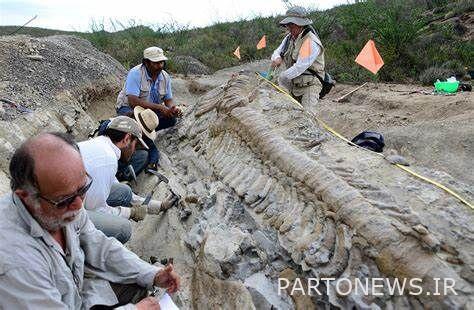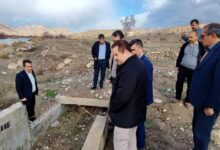Where is the paradise of the paleontologists of the world?

The high density of vertebrate fossils of seven to nine million years old has turned the Maragheh fossil region into a paradise for paleontologists, and has put the mysterious world of animals such as elephants, giraffes, tigers, swords, cows, deer, rhinos and horses ahead of paleontologists around the world. .
According to IRNA, the “Maragheh Fossil Zone” is one of the five most important vertebrate fossil zones in the world, according to experts, and is of special importance in terms of paleontological repository and study of ancient geography. The examples available on the Maragheh site can be used to introduce more global capacities.
According to officials, based on geological and paleontological research, animal fossils extracted from the Maragheh fossil region belong to the ancestors of modern animals in Africa, and this has made paleontological studies in this ancient city even more interesting, to the point that the paleontological research center in Maragheh Is established.
The head of Maragheh Environmental Protection Department also says about this attractiveness and special importance of the fossil zone of this city: Maragheh fossil zone is located in the migration routes of tertiary mammals, ie migration routes between Europe, Africa and East Asia, and fossil species (mammals) in Miocene The upper part of the Azerbaijani strip, especially in the Maragheh site, has added to its importance.
According to Gholamreza Zare, the high density of fossil parts per unit volume of fossil lenses, the wide distribution of vertebrate fossil lenses in an area of about 40,000 hectares, the high diversity of animal species in drilled lenses and relatively easy access to vertebrate fossil lenses and proper preservation of parts Fossilization in Maragheh site compared to other vertebrate fossil sites in the world has also increased its importance.
What are the capacities of Maragheh fossil region?
According to experts, the Maragheh fossil region is a suitable platform for paleontological studies in the fields of identifying and introducing new vertebrate fossil species and setting world records and studying the country’s ancient geography in the “Late Miocene”.
The Executive Secretary of the 2nd National Conference on “Ancient Biodiversity” and the 15th Conference of the Iranian Paleontological Society, which will be held in Maragheh in June 1401, believes that this region has the capacity to study the ancient Iranian climatology, plate tectonics in Late Miocene and Pliocene Iran and the establishment of a research center and a museum of fossils to display the country’s fossil records.
Zare added: “This region also has the capacity to create field museums to expand ecotourism with the aim of managing and sustainable development of the region and national and global registration and benefiting from international facilities.”
He continued: “By national and global registration of the fossil region, national credits and financial and scientific assistance of UNESCO can be used. By holding international conferences and workshops, the scientific credibility and tourism indicators of the region can be increased and the country’s scientific growth and implementation of resistance economy can be implemented.” He took positive steps at the regional and national level.
The need to extract and study the fossils of vertebrates in the ossified Maragheh Formation
The importance of the Maragheh fossil region on the one hand and the erosion and weathering of the layers containing fossil lenses, land degradation by the population and profiteering and damage to fossils on the other hand, has made the extraction and study of vertebrate fossils in the Maragheh region mandatory.
The head of Maragheh Environmental Protection Department believes that the cold region and snow and rain, the type of texture and construction of sediments in Maragheh Formation, low compaction of sediments and lack of cementation of sediment particles facilitate the infiltration of surface water into fossilized layers. Has washed away the material inside the bone tissue and made the parts loose and vulnerable; In addition, the presence of surface erosion agents also destroys fossil parts more than before.
“Due to the agricultural nature of the area, the expansion of apple orchards and the leveling of land by local residents, a significant number of fossilized lenses have been destroyed and this trend is increasing,” Zare said.
He also referred to profiteering and harming fossils. Preservation of agricultural lands destroyed fossilized layers and destroyed a significant number of fossil lenses.
He continued: “Others also resorted to illegal and unprofessional drilling in the hope of making a financial profit, and to counter these profiteering measures, protecting the fossilized layers and timely extraction of fossil lenses is the only solution.”
He also stressed that according to the Supreme Leader’s emphasis on using the existing capacities to promote the country’s scientific position, it is necessary to pay attention to the science of fossil science, which is about 70% of the country’s income from fossil fuels.
He continued: “By enriching the paleontological museums and studying the fossils of the country, on the one hand, we can take steps towards the orders of the leadership and on the other hand, provide the ground for being in the first level of the region in terms of paleontology.”
According to him, and considering the importance of the vertebrate fossil branch in paleontology, it can be used in the economic prosperity of our country by expanding ecotourism in the form of a geopark.
The Maragheh fossil region has international scientific and research value
The CEO of the Maragheh Environmental Protection Association, who is one of the well-known activists in this field and the former head of the Maragheh Environmental Protection Agency, said: So far, researchers and paleontologists from many different countries such as Spain, France, Austria, Russia, Japan and dozens of other countries They have visited the region and all of them agree that the Maragheh region has international scientific and research value and is a paradise for paleontologists in the world.
“Ali Moshtaghpour” added: “Some fossils of Maragheh region are kept in the Museum of Natural History of the Environmental Protection Agency and other countries, and many geology and fossilology students in Iran and other countries are interested in studying the Maragheh fossil region.”
He also emphasized the protection and extraction of fossils in this region and said: “This international capacity can be used for the development of environmental tourism as well as the development of paleontology, and the demand of the Samans will be very effective in this regard.”
According to IRNA, the history of studies on the ossified Maragheh Formation dates back to 1840; When a Russian businessman bought the collected fossils from Maragheh and sent them to Dorpat University; It was after that that the paleontologists of foreign paleontologists opened their feet to Maragheh one after another, and if they are properly planned, many more of them can be brought to Maragheh.

